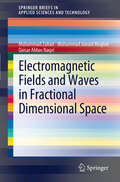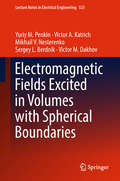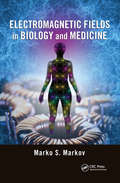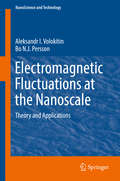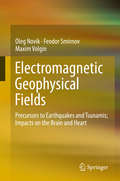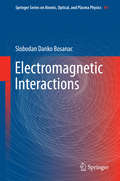- Table View
- List View
Electromagnetic Fields and Biomembranes
by M. MarkovThe First International School on "Electromagnetic Fields and Biomembranes" took place in Pleven, Bulgaria on 6-12 October 1986. It was designed as an advanced course through a collaboration of the Biological Faculty of Sofia University and the Council of the Bioelectrochemical Society. In an advanced course the lecturers are specialized in particular areas, and the students are usually specialists in related areas. We have captured the expertise of both groups of participants in this volume. The longer papers prepared by the lecturers are joined with the shorter papers based on the posters presented by the "students" to provide a summary of the school as well as an indication of current research directions in the field. The course was designed to provide the latest information about biomembrane structure and function, covering the properties of both the lipid matrix and the recently characterized proteins that function as specialized channels and receptors. Real membranes and various models were covered, with an emphasis on understanding their mechanisms of interaction with various exogenous stimuli (e.g., electric, magnetic, light, etc.). Several practical applications of this information (e.g., electroporation, electro-fusion) were also presented with indications of the possibilities for new developments in biotechnology. The mixture of basic science with practical applications, together with the int~rmingling of lecturers and students from many different countries produced a stimulating atmosphere and effective teaching. We hope that this volume will transmit some of this atmosphere.
Electromagnetic Fields and Circadian Rhythmicity (Circadian Factors in Human Health and Performance)
by Moore Ede Moore-EdeThis book is the first in a new series entitled ''Advances in Circadian Physiology." Our aim in this and subsequent volumes is to document and critically analyze the state of knowledge on biological clocks, circadian rhythms and their applications to human health, safety, performance and productivity. In the past twenty years, scientists have uncovered an elegant system of biological clocks in the brain that govern the daily rhythms of sleep and alertness, hormone levels and temperature and a myriad other aspects of body function. From the first identification of the suprachiasmatic biological clock in the early 1970s, this field of research has exploded in information and implication. These biological clocks, so perfectly attuned to the pace of a bygone era, are the root cause of the human fatigue, error, accidents and reduced productivity precipi tated by the around-the-clock challenges of today's industry and society. Research on these clocks offers the promise of fundamental solutions which can help the human race adjust physiologically to the technology-paced world we have created.
Electromagnetic Fields and Life
by A. PresmanA broad region of the electromagnetic spectrum long assumed to have no influence on living systems under natural conditions has been critically re-examinjld over the past decade. This spectral region extends from the superhigh radio frequencies, through de creasing frequencies, to and including essentially static electric and magnetic fields. The author of this monograph, A. S. Presman, has reviewed not only the extensive Russian literatur!;"l, but also al most equally comprehensively the non-Russian literature, dealing with biological influences of these fields. Treated also is literature shedding some light on possible theoretical foundations for these phenomena. A substantial, rapidly increaSing number of studies in many laboratories and countries has now clearly established bio logical influences which are independent of the theoretically pre dictable, simple thermal effects. Indeed many of the effects are produced by field strengths very close to those within the natural environment. The author has, even more importantly, set forth a novel, imaginative general hypothesis in which it is postulated that such electromagnetic fields normally serve as conveyors of information from the environment to the organism, within the organism, and among organisms. He postulates that in the course of evolution or ganisms have come to employ these fields in conjunction with the well-known sensory, nervous, and endocrine systems in effecting coordination and integration.
Electromagnetic Fields and Waves in Fractional Dimensional Space (SpringerBriefs in Applied Sciences and Technology)
by Muhammad Zubair Muhammad Junaid Mughal Qaisar Abbas NaqviThis book presents the concept of fractional dimensional space applied to the use of electromagnetic fields and waves. It provides demonstrates the advantages in studying the behavior of electromagnetic fields and waves in fractal media. The book presents novel fractional space generalization of the differential electromagnetic equations is provided as well as a new form of vector differential operators is formulated in fractional space. Using these modified vector differential operators, the classical Maxwell's electromagnetic equations are worked out. The Laplace's, Poisson's and Helmholtz's equations in fractional space are derived by using modified vector differential operators.
Electromagnetic Fields Excited in Volumes with Spherical Boundaries (Lecture Notes in Electrical Engineering #523)
by Yuriy M. Penkin Victor A. Katrich Mikhail V. Nesterenko Sergey L. Berdnik Victor M. DakhovThis book discusses the problem of electromagnetic wave excitation in spatial regions with spherical boundaries and the accurate mathematical modeling based on numerical and analytical methods to significantly reduce the time required for developing new antenna devices. It particularly focuses on elements and systems on mobile objects of complex shape that are made of new technological materials. The experimental development of such devices and systems is an extremely time-consuming, lengthy, and expensive process. The book is intended for senior and postgraduate students and researchers working in the fields of radiophysics, radio engineering and antenna design. The authors assume that readers understand the basics of vector and tensor analysis, as well as the general theory of electrodynamics. The original results presented can be directly used in the development of spherical antennas and antenna systems for the mobile objects. The book addresses problems concerning the construction of Green’s functions for Hertz potentials in electrodynamic volumes with spherical boundaries, and solves these clearly and concisely. It also uses specific examples to analyze areas where the results could potentially be applied. The book covers the following topics: · excitation of electromagnetic fields in coordinate electrodynamic volumes; · Green’s functions for spherical resonators; · Green’s functions for infinite space outside of spherical scatterers; · electromagnetic fields of dipole radiators on spherical scatterers; · electromagnetic fields of thin radial impedance vibrators on perfectly conducting spheres; · electrodynamic characteristics of narrow slots in spherical surfaces; · multi-element and combined vibrator-slot radiators on spherical surfaces.
Electromagnetic Fields in Biological Systems
by James C. LinAs wireless technology becomes more sophisticated and accessible to more users, the interactions of electromagnetic fields with biological systems have captured the interest not only of the scientific community but also the general public. Unintended or deleterious biological effects of electromagnetic fields and radiation may indicate grounds for
Electromagnetic Fields in Biological Systems
by James C. LinSpanning static fields to terahertz waves, this volume explores the range of consequences electromagnetic fields have on the human body. Topics discussed include essential interactions and field coupling phenomena; electric field interactions in cells, focusing on ultrashort, pulsed high-intensity fields; dosimetry or coupling of ELF fields into biological systems; and the historical developments and recent trends in numerical dosimetry. It also discusses mobile communication devices and the dosimetry of RF radiation into the human body, exposure and dosimetry associated with MRI and spectroscopy, and available data on the interaction of terahertz radiation with biological tissues, cells, organelles, and molecules.
Electromagnetic Fields in Biology and Medicine
by Marko S. MarkovThrough a biophysical approach, Electromagnetic Fields in Biology and Medicine provides state-of-the-art knowledge on both the biological and therapeutic effects of Electromagnetic Fields (EMFs). The reader is guided through explanations of general problems related to the benefits and hazards of EMFs, step-by-step engineering processes, and basic r
Electromagnetic Fluctuations at the Nanoscale: Theory and Applications (NanoScience and Technology)
by Aleksandr I. Volokitin Bo N.J. PerssonThis book provides a general formalism for the calculation of the spectral correlation function for the fluctuating electromagnetic field. The procedure is applied to the radiative heat transfer and the van der Waals friction using both the semi-classical theory of the fluctuating electromagnetic field and quantum field theory. Applications of the radiative heat transfer and non-contact friction to scanning probe spectroscopy are presented. The theory gives a tentative explanation for the experimental non-contact friction data. The book explains that radiative heat transfer and the van der Waals friction are largely enhanced at short separations between the bodies due to the evanescent electromagnetic waves. Particular strong enhancement occurs if the surfaces of the bodies can support localized surface modes like surface plasmons, surface polaritons or adsorbate vibrational modes. An electromagnetic field outside a moving body can also be created by static charges which are always present on the surface of the body due to inhomogeneities, or due to a bias voltage. This electromagnetic field produces electrostatic friction which can be significantly enhanced if on the surface of the body there is a 2D electron or hole system or an incommensurate adsorbed layer of ions exhibiting acoustic vibrations.
Electromagnetic Form Factors of Charmed Baryons in Lattice QCD (Springer Theses)
by Kadir Utku CanThis thesis presents the first lattice quantum chromodynamics (QCD) approach to the charmed baryon regime, building on the knowledge and experience gained with former lattice QCD applications to nucleon structure. The thesis provides valuable insights into the dynamics of yet unobserved charmed baryon systems. Most notably, it confirms that the expectations of model or effective field theoretical calculations of heavy-hadron systems hold qualitatively, while also demonstrating that they conflict with the quantitative results, pointing to a tension between these complementary approaches. Further, the book presents a cutting-edge approach to understanding the structure and dynamics of hadrons made of quarks and gluons using QCD, and successfully extends the approach to charmed hadrons. In particular, the thesis investigate a peculiar property of charmed hadrons whose dynamics, i.e., structure, deviates from their counterparts, e.g., those of protons and neutrons, by employing the lattice QCD approach —a state-of-the-art numerical method and the powerful ab initio, non-perturbative method.
Electromagnetic Foundations of Electrical Engineering
by J. A. Brandão FariaThe applications of electromagnetic phenomena within electrical engineering have been evolving and progressing at a fast pace. In contrast, the underlying principles have been stable for a long time and are not expected to undergo any changes. It is these electromagnetic field fundamentals that are the subject of discussion in this book with an emphasis on basic principles, concepts and governing laws that apply across the electrical engineering discipline. Electromagnetic Foundations of Electrical Engineering begins with an explanation of Maxwell’s equations, from which the fundamental laws and principles governing the static and time-varying electric and magnetic fields are derived. Results for both slowly- and rapidly-varying electromagnetic field problems are discussed in detail. Key aspects: Offers a project portfolio, with detailed solutions included on the companion website, which draws together aspects from various chapters so as to ensure comprehensive understanding of the fundamentals. Provides end-of-chapter homework problems with a focus on engineering applications. Progresses chapter by chapter to increasingly more challenging topics, allowing the reader to grasp the more simple phenomena and build upon these foundations. Enables the reader to attain a level of competence to subsequently progress to more advanced topics such as electrical machines, power system analysis, electromagnetic compatibility, microwaves and radiation. This book is aimed at electrical engineering students and faculty staff in sub-disciplines as diverse as power and energy systems, circuit theory and telecommunications. It will also appeal to existing electrical engineering professionals with a need for a refresher course in electromagnetic foundations.
Electromagnetic Foundations of Solar Radiation Collection: A Technology for Sustainability (Green Energy and Technology)
by Alan J. SangsterThis text seeks to illuminate, mainly for the electrical power engineers of the future, the topic of large scale solar flux gathering schemes, which arguably represent the major source of renewable power available. The aim of the content is to impart, from an electromagnetic perspective, a deep and sound understanding of the topic of solar flux collection, ranging from the characteristics of light to the properties of antennas. To do this five chapters are employed to provide a thorough grounding in relevant aspects of electromagnetism and electromagnetic waves including optics, electromagnetic radiation and reception, aperture antennas and array antennas and the quantum electrodynamics aspects of optical absorption, as it relates to photovoltaic techniques. The principles developed in these chapters are then used to underpin and elucidate the main chapters on photovoltaic collectors, concentrated solar power collectors, satellite based collection systems and optical nantennas. To establish the novel and transformative renewable technologies, which civilisation will soon require, in order to achieve sustainability quickly and effectively, the availability of professional engineers and scientists with a thorough and commanding grasp of the fundamental science is an absolutely essential prerequisite. This book provides this for solar power generating systems.
Electromagnetic Geophysical Fields: Precursors to Earthquakes and Tsunamis; Impacts on the Brain and Heart
by Oleg Novik Feodor Smirnov Maxim VolginThis book develops the theory of electromagnetic (EM) precursors to seaquakes (i.e. underwater earthquakes) and tsunamis, including the sequential stages of the transformation of a weak seismic mechanical excitation of the sea bottom into EM signals in the atmosphere. It further examines the relationship between geophysics and biophysics, using appropriate mathematical support, and a new model of the magnetic location of the epicenter of a possible land earthquake is described, as well as a block-scheme of the multidisciplinary multilevel seaquake monitoring complex. Also discussed are measured changes of brain bioelectric activity and heart functioning under the influence of moderate geomagnetic storms. Written for researchers and specialists (e.g. upper level undergraduates, postgraduates, scientists) in mathematical, computational, geophysical, biophysical, geodynamical, seismological and prognostic disciplines, this book provides multidisciplinary data and analytical tools supporting the theory and practice of seismic prognosis, promoting further understanding of novel marine and land monitoring systems.
Electromagnetic Imaging for a Novel Generation of Medical Devices: Fundamental Issues, Methodological Challenges and Practical Implementation (Lecture Notes in Bioengineering)
by Francesca Vipiana Lorenzo CroccoThis book offers the first comprehensive coverage of microwave medical imaging, with a special focus on the development of novel devices and methods for different applications in both the diagnosis and treatment of various diseases. Upon introducing the fundamentals of electromagnetic imaging, it guides the readers to their use in practice by providing extensive information on the corresponding measurement and testing techniques. In turn, it discusses current challenges in data processing and analysis, presenting effective, novel solutions, developed by different research groups. It also describes state-of-the-art medical devices, which were designed for specific applications, such as brain stroke monitoring, lymph node diagnosis, image-guided hyperthermia, and chemotherapy response monitoring. The chapters, which report on the results of the EU-funded project EMERALD (ElectroMagnetic imaging for a novel genERation of medicAL Devices) are written by leading European engineering groups in electromagnetic medical imaging, whose coordinated action is expected to accelerate the translation of this technology “from research bench to patient bedside”. All in all, this book offers an authoritative guide to microwave imaging, with a special focus on medical imaging, for electrical and biomedical engineers, and applied physicists and mathematicians. It is also intended to inform medical doctors and imaging technicians on the state-of-the-art in non-invasive imaging technologies, at the purpose of inspiring and fostering the translation of research into clinical prototypes, by promoting a stronger collaboration between academic institutions, industrial partners, hospitals, and university medical centers.
Electromagnetic Induction Phenomena (Springer Series in Electronics and Photonics #16)
by David SchieberFrom an engineering perspective, Electrodynamics is the province of two cul tures. The most easily identified of the two is primarily concerned with phe nomena in which the propagation of electromagnetic waves is crucial. Includ ed are the designers of microwave circuits, of antennae and of many-wave length communication channels. The interests of the second group focus on dynamical processes associated with the evolution of field sources, whether these be electrons and holes migrating in a semiconductor, or currents diffus ing in a moving metal. Because the second culture is primarily concerned with the interaction be tween electromagnetic fields and media, where the latter are often responsible for the dominant dynamical processes, it addresses applications that are more widely ranging. A few from a very long list would include electrostatic print ing, rotating machines, power transmission apparatus, the electromagnetics of biological systems and physical electronics. Whether by nature or by de sign, the phenomena of interest are generally electro quasi static or magneto quasistatic in this second branch of electrodynamics. It is tempting to say that the two branches of electrodynamics can be distinguished by the frequency range, but electron-beam and microwave-magnetic devices, with their respec tive plasma oscillations and spin waves, are examples where the frequencies can be in the GHz range while the fundamental interactions are quasistatic. By design, so also are those that determine the frequency response of a transistor.
Electromagnetic Instabilities in an Inhomogeneous Plasma
by A.B MikhailovskiiElectromagnetic Instabilities in an Inhomogeneous Plasma presents a comprehensive survey of the theory of electromagnetic instabilities in a magnetized inhomogeneous plasma, mainly in the classical approximation of straight and parallel magnetic field lines as well as magnetic-field curvature effects. Using his expertise and experience, the author skillfully guides the reader through the theory; presenting the most important results from leading Russian and Western scientists. This timely and important work will enable new or experienced researchers to improve their knowledge of this important field of plasma research.
Electromagnetic Instabilities in an Inhomogeneous Plasma (Series In Plasma Physics Ser. #1)
by A.B MikhailovskiiElectromagnetic Instabilities in an Inhomogeneous Plasma presents a comprehensive survey of the theory of electromagnetic instabilities in a magnetized inhomogeneous plasma, mainly in the classical approximation of straight and parallel magnetic field lines as well as magnetic-field curvature effects. Using his expertise and experience, the author skillfully guides the reader through the theory; presenting the most important results from leading Russian and Western scientists. This timely and important work will enable new or experienced researchers to improve their knowledge of this important field of plasma research.
Electromagnetic Interaction with Biological Systems
by James LinEver since the early 1940's, electromagnetic energy in the nonionizing spectrum has contributed to the enhanced quality of life in a variety of ways. Aside from their well-known roles in communication, entertainment, industry and science, electromagnetic energy has come into wide spread use in biology and medicine. In addition to the intended purposes, these energies produce other effects which have been shown to influence the life processes of living organisms. It is noteworthy that these energies are not only harmless in ordinary quantities but are actually necessary for modern life, indeed without which life as we know it would be impossible. The purpose of this book is to present a succinct summary of the interaction of electromagnetic fields and waves with biological systems as they are now known. The subject matter is interdisciplinary and is based primarily on presentations scheduled for a joint symposium at the XXII General Assembly of the International Union of Radio Science, held in Tel Aviv, Israel from Tuesday, August 25 to Wednesday, September 2, 1987. The symposium was jointly sponsored by the Bioelectromagnetics Society in cooperation with the International Radiation Protection Association. The choice of topics was made to facilitate the application and to stimulate the use of nonioni zing electromagnetic energy in biology and medicine, and to increase the awareness and to promote the consideration of radiation safety by electrical engineers and experimental physicists.
Electromagnetic Interactions (Springer Series on Atomic, Optical, and Plasma Physics #94)
by Slobodan Danko BosanacThis book is devoted to theoretical methods used in the extreme circumstances of very strong electromagnetic fields. The development of high power lasers, ultrafast processes, manipulation of electromagnetic fields and the use of very fast charged particles interacting with other charges requires an adequate theoretical description. Because of the very strong electromagnetic field, traditional theoretical approaches, which have primarily a perturbative character, have to be replaced by descriptions going beyond them. In the book an extension of the semi-classical radiation theory and classical dynamics for particles is performed to analyze single charged atoms and dipoles submitted to electromagnetic pulses. Special attention is given to the important problem of field reaction and controlling dynamics of charges by an electromagnetic field.
Electromagnetic Interactions and Field Theory: Proceedings of the XIV. Internationale Universitätswochen für Kernphysik 1975 der Karl-Franzens-Universität Graz at Schladming (Steiermark, Austria), 24. February - 7. March 1975 (Few-Body Systems #14/1975)
by Paul UrbanElectromagnetic Interactions of Hadrons (Nuclear Physics Monographs)
by A. DonnachieWhile electromagnetic interactions were first used to probe the structure of elementary particles more than 20 years ago, their importance has only become fully evident in the last 10 years. In the resonance region, photo production experiments have provided clear evidence for simple quark model ideas, and confirmed the Melosh-transformed SU(6)w as a relevant symmetry classification. At higher energies, their most striking feature is their similarity to hadron-induced reactions, and they have provided fresh insight into the ideas developed to explain strong-interaction physics. New dimensions are added by taking the photon off mass shell, both in the spacelike region, where the development of high-energy electron and muon beams has led to the discovery and study of scaling and the intro duction of "partons," and even more dramatically in the timelike region, where the development of high-energy electron-positron storage rings has led to the exciting discoveries of the last four years. In view of the immense interest stimulated by these developments, an extensive review of our present state of knowledge is both timely and useful. Because of the very wide range of the subject, a cooperative venture presents itself as the most suitable format and is the one we have adopted here. The emphasis throughout is primarily, but not entirely, on phenomenology, concentrating on describing the main features of the experimental data and on the theoretical ideas used directly in their inter pretation.
Electromagnetic, Mechanical, and Transport Properties of Composite Materials
by Rajinder PalIn the design, processing, and applications of composite materials, a thorough understanding of the physical properties is required. It is important to be able to predict the variations of these properties with the kind, shape, and concentration of filler materials. The currently available books on composite materials often emphasize mechanical pro
Electromagnetic Metasurfaces: Theory and Applications (Wiley - IEEE)
by Karim Achouri Christophe CalozDiscover a comprehensive exploration of recent developments and fundamental concepts in the applications of metasurfaces. In Electromagnetic Metasurfaces: Theory and Applications, distinguished researchers and authors Karim Achouri and Christophe Caloz deliver an introduction to the fundamentals and applications of metasurfaces and an insightful analysis of recent and future developments in the field. The book describes the precursors and history of metasurfaces before continuing on to an exploration of the physical insights that can be gleaned from the material parameters of the metasurface. You’ll learn how to compute the fields scattered by a metasurface with known material parameters being illuminated by an arbitrary incident field, as well as how to realize a practical metasurface and relate its material parameters to its physical structures. The authors provide examples to illustrate all the concepts discussed in the book to improve and simplify reader understanding. Electromagnetic Metasurfaces concludes with an incisive discussion of the likely future directions and research opportunities in the field. Readers will also benefit from the inclusion of: A thorough introduction to metamaterials, the concept of metasurfaces, and metasurface precursors An exploration of electromagnetic modeling and theory, including metasurfaces as zero-thickness sheets and bianisotropic susceptibility tensors A practical discussion of susceptibility synthesis, including four-parameters synthesis, more than four-parameters synthesis, and the addition of susceptibility components A concise treatment of scattered-field analysis, including approximate analytical methods, and finite-difference frequency-domain techniques Perfect for researchers in metamaterial sciences and engineers working with microwave, THz, and optical technologies, Electromagnetic Metasurfaces: Theory and Applications will also earn a place in the libraries of graduate and undergraduate students in physics and electrical engineering.
Electromagnetic Metasurfaces: Theory and Applications (Wiley - IEEE)
by Karim Achouri Christophe CalozDiscover a comprehensive exploration of recent developments and fundamental concepts in the applications of metasurfaces. In Electromagnetic Metasurfaces: Theory and Applications, distinguished researchers and authors Karim Achouri and Christophe Caloz deliver an introduction to the fundamentals and applications of metasurfaces and an insightful analysis of recent and future developments in the field. The book describes the precursors and history of metasurfaces before continuing on to an exploration of the physical insights that can be gleaned from the material parameters of the metasurface. You’ll learn how to compute the fields scattered by a metasurface with known material parameters being illuminated by an arbitrary incident field, as well as how to realize a practical metasurface and relate its material parameters to its physical structures. The authors provide examples to illustrate all the concepts discussed in the book to improve and simplify reader understanding. Electromagnetic Metasurfaces concludes with an incisive discussion of the likely future directions and research opportunities in the field. Readers will also benefit from the inclusion of: A thorough introduction to metamaterials, the concept of metasurfaces, and metasurface precursors An exploration of electromagnetic modeling and theory, including metasurfaces as zero-thickness sheets and bianisotropic susceptibility tensors A practical discussion of susceptibility synthesis, including four-parameters synthesis, more than four-parameters synthesis, and the addition of susceptibility components A concise treatment of scattered-field analysis, including approximate analytical methods, and finite-difference frequency-domain techniques Perfect for researchers in metamaterial sciences and engineers working with microwave, THz, and optical technologies, Electromagnetic Metasurfaces: Theory and Applications will also earn a place in the libraries of graduate and undergraduate students in physics and electrical engineering.
Electromagnetic Methods in Geophysics: Applications in GeoRadar, FDEM, TDEM, and AEM
by Fabio Giannino Giovanni LeucciDiscover the utility of four popular electromagnetic geophysical techniques In GeoRadar, FDEM, TDEM, and AEM Methods, accomplished researchers Fabio Giannino and Giovanni Leucci deliver an in-depth exploration of the theory and application of four different electromagnetic geophysical techniques: ground penetrating radar, the frequency domain electromagnetic method, the time domain electromagnetic method, and the airborne electromagnetic method. The authors offer a full description of each technique as they relate to the economics, planning, and logistics of deploying each of them on-site. The book also discusses the potential output of each method and how it can be combined with other sources of below- and above-ground information to create a digitized common point cloud containing a wide variety of data. Giannino and Leucci rely on 25 years of professional experience in over 40 countries around the world to provide readers with a fulsome description of the optimal use of GPR, FDEM, TDEM, and AEM, demonstrating their flexibility and applicability to a wide variety of use cases. Readers will also benefit from the inclusion of: A thorough introduction to electromagnetic theory, including the operative principles and theory of ground penetrating radar (GPR) and the frequency domain electromagnetic method (FDEM) An exploration of hardware architecture and surveying, including GPR, FDEM, time domain electromagnetic method (TDEM), and airborne electromagnetic (AEM) surveying A collection of case studies, including a multiple-geophysical archaeological GPR survey in Turkey and a UXO search in a building area in Italy using FDEM /li> Discussions of planning and mobilizing a campaign, the shipment and clearance of survey equipment, and managing the operative aspects of field activity Perfect for forensic and archaeological geophysicists, GeoRadar, FDEM, TDEM, and AEM Methods will also earn a place in the libraries of anyone seeking a one-stop reference for the planning and deployment of GDR, FDEM, TDEM, and AEM surveying techniques.



